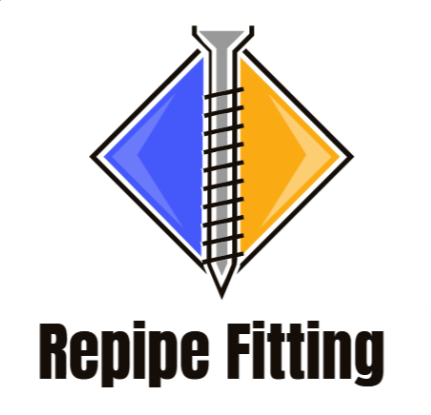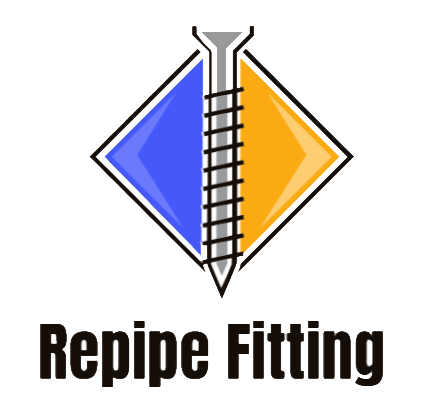Introduction
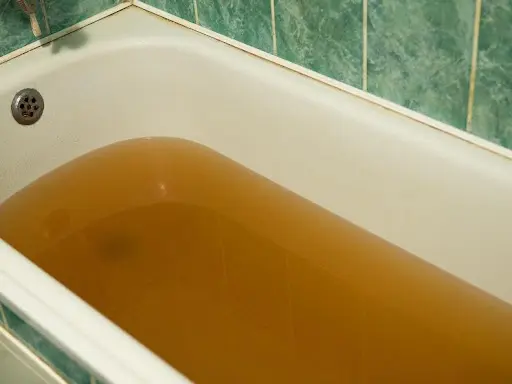
Hey there, dear reader! If you’ve stumbled upon this guide, chances are you’re dealing with the pesky problem of your toilet backing up into shower. It’s a situation no one wants to find themselves in, but don’t fret! As an experienced plumber, I’m here to guide you through the ins and outs of this issue. By the end of this guide, you’ll have a clear understanding of why your toilet is backing up into your shower and how to address it.
A brief overview of the problem: sewage backing up into showers and bathtubs.
Imagine you’re taking a relaxing shower, and suddenly, sewage starts backing up. Not the most pleasant thought, right? This issue often arises due to blockages in the main sewer line. These blockages can be caused by a variety of factors, from invasive tree roots to grease buildup. When the main sewer line is blocked, the sewage has nowhere to go but back up into your shower drain.
The importance of addressing the issue promptly due to health risks.
Sewage contains harmful bacteria and pathogens. If left untreated, sewage backing up into your shower can pose serious health risks. Moreover, the longer you wait, the more damage it can cause to your plumbing system. It’s crucial to address the issue promptly to protect your health and save on potential repair costs.
Understanding the Problem
How waste travels from toilets to the main sewer line.

When you flush your toilet, the waste travels through a series of pipes before reaching the main sewer line. This sewer line is like the highway for all the waste from your home. Everything from your sinks, showers, and toilets converge here, eventually leading the waste to a sewage treatment facility.
Reasons why toilets back up into showers or bathtubs.
Now, imagine a traffic jam on this waste highway. When there’s a blockage or congestion, the waste has to find an alternative route, and unfortunately, that might be your shower drain. Let’s delve deeper into the common culprits behind these blockages.
Blockages in the main sewer line.

- Tree Roots: These sneaky invaders can grow into your sewer line, especially if you have older cast iron or terracotta pipes.
- Grease Buildup: Over time, grease from our kitchens can solidify in the main sewer line, causing significant blockages.
- Flushable Wipes: Despite their name, these are a notorious culprit for clogging up the sewer line.
- Soil Failure: Particularly with terracotta pipes, soil failure can cause a collapse, leading to blockages.
- Septic System Overload: If your home uses a septic system, it might be time to get your septic tank pumped.
Clogs closer to the bathroom.
- Hair and Soap Scum: These can accumulate over time, causing a blockage in the shower drain.
- Chemical Drain Openers: Ironically, over-relying on these can cause sediment buildup, leading to clogs.
- Foreign Objects: From kids’ toys to excessive amounts of toilet paper, these can cause immediate blockages.
Common Causes of Clogs
Let’s start by understanding the root causes of these clogs, so you can prevent them in the future.
Tree roots infiltrating sewer lines.
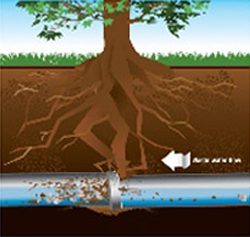
One of the most common culprits behind major blockages in the main sewer line is invasive tree roots. Trees, always in search of water, can find their way into even the tiniest cracks in your sewer line, especially if you have:
- Cast Iron Pipes: Over time, these can corrode and create openings for tree roots.
- Terracotta Pipes: These are more porous and can be easily infiltrated by tree roots.
Old piping materials like cast iron and terracotta.
Speaking of old pipes, both cast iron and terracotta pipes have a limited lifespan. Over the years, they can deteriorate, leading to:
- Sediment Buildup: This can reduce the flow of sewage, causing backups.
- Breaks and Cracks: These can allow external debris and tree roots to enter.
Soil shifts affecting sewer lines.

Soil failure or shifts in the ground can exert pressure on your sewer line, leading to:
- Pipe Misalignment: This can trap waste, causing blockages.
- Pipe Collapse: A complete failure of a section of the sewer line.
Household items and habits:
Now, let’s talk about some of the things we might be doing unknowingly that can cause blockages closer to home.
Pouring grease down drains.
Grease might seem harmless when it’s liquid, but as it cools down, it solidifies, leading to grease buildup in your drains. Over time, this can cause a complete blockage.
Using certain drain cleaners.
While they might seem like a quick fix, some chemical drain openers can cause sediment buildup, especially if overused.
Flushing non-flushable items like wipes.
Even if they’re labeled as “flushable,” these wipes don’t break down as easily as toilet paper, leading to clogs.
Hair, soap particles, toys, jewelry, and more.
All these can accumulate in your shower drain, causing immediate blockages. Regularly cleaning your shower drain can help prevent this.
At-Home Remedies for Clogs
There are a few at-home remedies you can try. As an experienced plumber, I’ve seen many a clog, and I’m here to share some DIY solutions that might just do the trick for you. So, roll up those sleeves, and let’s get to work!
Dish Soap & Hot Water Method
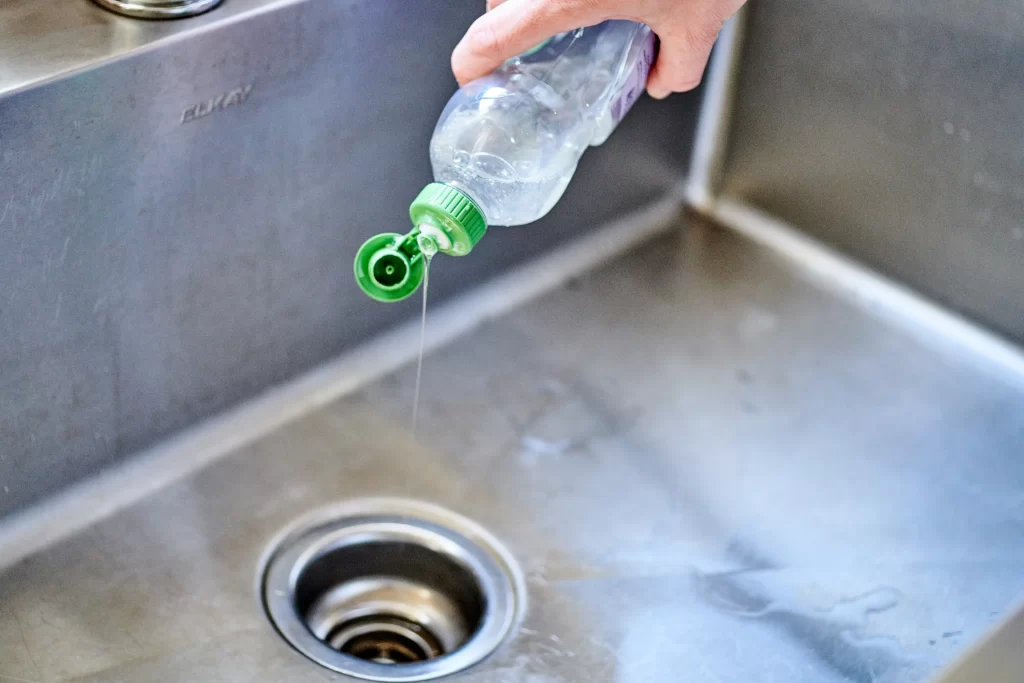
Ah, the magic of dish soap and hot water! This dynamic duo can be quite effective, especially against grease buildup in your shower drain. Here’s how to do it:
- Boil about a gallon of water.
- While waiting, pour a good squirt of dish soap down the problematic drain.
- Once the water’s boiled, pour it slowly down the drain.
- Wait for a few minutes, then test by running water to see if the blockage has cleared.
Wire Coat Hanger Technique
Sometimes, the problem is just a pesky obstruction near the surface of the drain. For this, the humble wire coat hanger comes to the rescue.
- Straighten out the hanger but leave a small hook at one end.
- Remove the shower drain cover.
- Gently insert the hooked end, fishing around to catch any obstructions like hair or soap scum.
- Pull out the debris and dispose of it properly.
Natural Solutions:
For those who prefer eco-friendly solutions, Mother Nature has got you covered.
Salt, Borax, & Vinegar
This powerful combination can help dissolve even stubborn blockages.
- Mix equal parts of salt, borax, and vinegar.
- Pour the mixture down the drain.
- Wait for about an hour, then flush with hot water.
Baking Soda Combinations
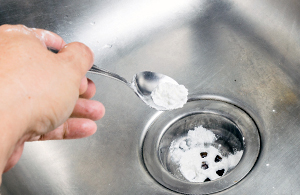
Baking soda is quite the versatile ingredient when it comes to clearing drains. Here are a few combinations to try:
- Baking Soda & Vinegar: Pour half a cup of baking soda followed by an equal amount of vinegar. Wait for the fizzing action to subside, then flush with hot water.
- Baking Soda & Salt: Mix equal parts and pour down the drain. Wait for a bit, then rinse with boiling water.
- Baking Soda, Cream of Tartar & Lemon Juice: Mix the baking soda and cream of tartar in equal parts. Add a few tablespoons of lemon juice to create a paste. Apply to the drain, wait, and rinse.
Advanced Solutions
So, you’ve tried the basic at-home remedies, and that pesky toilet is still backing up into your shower? Don’t worry; we’ve all been there. I’m here to guide you through some advanced solutions that can help tackle even the most stubborn of blockages. Let’s roll up our sleeves and dive deeper into the world of plumbing.
Using a Plunger
The good old plunger isn’t just for toilets! It can be a handy tool for clearing blockages in your shower drain too.
- Preparation: First, ensure there’s enough water in the shower to cover the base of the plunger.
- Seal and Plunge: Place the plunger over the shower drain, ensuring a good seal. Push down and pull up vigorously several times to create suction.
- Check: Remove the plunger and see if the water drains away. If not, give it another go!
Snaking the Drain
If the plunger doesn’t do the trick, it’s time to bring out the big guns: the plumbing snake or sewer snake.
- Insertion: Push the end of the snake into the shower drain.
- Rotation: Turn the handle, allowing the snake to go deeper into the drain.
- Retrieval: Once you feel resistance (that’s the blockage!), rotate the snake to break up the obstruction, then slowly pull it out.
- Clean Up: It might be a bit messy, so be sure to have some rags on hand.
Hydro-Jetting: A Professional Method to Clear Severe Clogs
Hydro-jetting is a method that uses high-pressure water to clear blockages. It’s especially effective against grease buildup and invasive tree roots.
- Inspection: Before hydro-jetting, a CCTV sewer camera inspection is often done to locate the blockage.
- Jetting: A high-pressure hose with a special nozzle is inserted into the drain, and water is blasted through to clear the obstruction.
- Final Check: Another inspection is done to ensure the blockage is completely cleared.
- Note: Hydro-jetting is a powerful method and should be done by licensed plumbers to avoid any potential damage.
When to Call a Professional
Hey there! It’s commendable that you’re taking the initiative to tackle the plumbing issue of your toilet backing up into the shower. But sometimes, despite our best efforts, the problem persists or even worsens. That’s when it’s time to call in the cavalry – the professionals. As an experienced plumber, I’m here to guide you on when and why you should consider professional intervention.
Recognizing Persistent Issues and Potential Damage
It’s essential to know when to wave the white flag and call for help. Here are some signs:
- Recurring Blockages: If you’ve cleared the blockage, but it keeps coming back, there might be a deeper issue.
- Water Overflow: If sewage starts to overflow from other outlets, it indicates a blockage in the main sewer line.
- Foul Odor: Persistent bad smells can be a sign of a severe blockage or a problem with your septic system.
- Slow Draining: If water is consistently slow to drain, even after you’ve tried clearing the blockage, it’s a sign of a more significant issue.
Benefits of Professional Intervention:
Sometimes, the DIY approach might not cut it. Here’s why calling a professional can be beneficial:
Preventing Further Damage
An experienced plumber can accurately diagnose the issue, ensuring that it’s addressed correctly the first time, preventing potential damage to your plumbing system.
Access to Specialized Tools
From CCTV sewer camera inspection to hydro-jetting, professionals have access to advanced tools that can address even the most stubborn blockages.
Comprehensive Clog Removal
Professionals can ensure that the entire blockage, from the shower drain to the main sewer line, is cleared, preventing future issues.
Ensuring the Problem is Fully Resolved
A professional won’t just clear the blockage; they’ll also advise on preventing future issues, whether it’s recommending drain cleaners or addressing invasive tree roots.
Warning Signs of a Blocked Sewer Line
Slow Draining Water
One of the most common and noticeable signs of a blocked sewer line is slow draining water. If you observe:
- Water pooling around the shower drain.
- The sink is taking longer than usual to drain.
- The flushing toilet not clearing out as swiftly as it should.
These might be indications that there’s a blockage in your main sewer line.
Gurgling Sounds from Drains
Ever heard that odd gurgling sound coming from your drains or toilet? That’s not a friendly ghost; it’s air trapped in your pipes due to a blockage. This sound is especially noticeable:
- After flushing the toilet.
- When draining the bathtub or sink.
- Sometimes even when using appliances like washing machines.
Frequent Clogs in Multiple Fixtures
If you’re experiencing clogs in more than one fixture, be it the sink, toilet, or shower drain, it’s a strong indication that the problem lies in the main sewer line and not just a localized blockage.
Wastewater Appearing in Unexpected Places
This is a big red flag! If you notice:
- Water backing up into the tub when you flush the toilet.
- Sinks filling with water when you run the washing machine.
- Or even worse, sewage making an unwelcome appearance in your yard.
It’s high time to address the issue.
Conclusion
Well, dear reader, we’ve journeyed through the intricate world of plumbing, specifically focusing on the issue of toilets backing up into showers. As an experienced plumber, I can’t stress enough the importance of understanding and addressing this issue. Let’s wrap up with some final thoughts.
The Importance of Timely Intervention
The moment you notice signs of a blockage, whether it’s slow-draining water, gurgling sounds, or the dreaded sewage backup, it’s crucial to act.
Delaying can lead to:
- Further damage to your plumbing system.
- Potential health risks due to exposure to sewage.
- Costlier repairs in the long run.
The Balance Between At-Home Remedies and Professional Solutions
While DIY methods like using baking soda & vinegar or a plunger can be effective for minor blockages, some issues require the expertise of a licensed plumber. Recognizing when to call in the professionals can save you time, money, and a lot of stress.
Perform Regular Maintenance to Prevent Future Issues
Prevention is better than cure. Regular maintenance, like checking for tree roots near your main sewer line or avoiding pouring grease down the drain, can go a long way in preventing blockages.
FAQ
Why is my toilet backing up into the shower?
A: This typically indicates a blockage in your main sewer line. Common culprits include invasive tree roots, grease buildup, or flushing non-flushable items like wipes.
Can I fix the problem myself?
A: Minor blockages can often be addressed with at-home remedies. However, for persistent or severe blockages, it’s best to call in a professional.
Are “flushable” wipes safe for my toilet?
A: Despite the name, many “flushable” wipes don’t disintegrate as quickly as toilet paper and can lead to blockages. It’s best to dispose of them in the trash.
How can I prevent my toilet from backing up into the shower in the future?
A: Regular maintenance, avoiding flushing non-flushable items, and being cautious about what goes down your drains can help. Also, consider regular inspections, especially if you have older plumbing systems like cast iron or terracotta pipes.
What are the health risks associated with sewage backing up into my shower?
A: Exposure to sewage can lead to various health issues, from skin infections to gastrointestinal problems. It’s essential to clean and disinfect the area thoroughly and seek medical attention if you experience any symptoms.
Why is my toilet backing up into the shower?
A: This typically indicates a blockage in your main sewer line. Common culprits include invasive tree roots, grease buildup, or flushing non-flushable items like wipes.
Can I fix the problem myself?
A: Minor blockages can often be addressed with at-home remedies. However, for persistent or severe blockages, it’s best to call in a professional.
Are “flushable” wipes safe for my toilet?
A: Despite the name, many “flushable” wipes don’t disintegrate as quickly as toilet paper and can lead to blockages. It’s best to dispose of them in the trash.
How can I prevent my toilet from backing up into the shower in the future?
A: Regular maintenance, avoiding flushing non-flushable items, and being cautious about what goes down your drains can help. Also, consider regular inspections, especially if you have older plumbing systems like cast iron or terracotta pipes.
What are the health risks associated with sewage backing up into my shower?
A: Exposure to sewage can lead to various health issues, from skin infections to gastrointestinal problems. It’s essential to clean and disinfect the area thoroughly and seek medical attention if you experience any symptoms.
